

Rob-n-Hild, oot and aboot eh? Sorry - 2022
|
Click links to jump to specific days: Start | Nerdy | The Largest... | Ornaments
|
|||||||||||||||||||||||||||||||||||||||||||||||||||||||||||||||
|
Kapuskasing - Val-d'Or (511 km, Driving time: 6 hours 50 minutes, Max elevation : 363 metres) 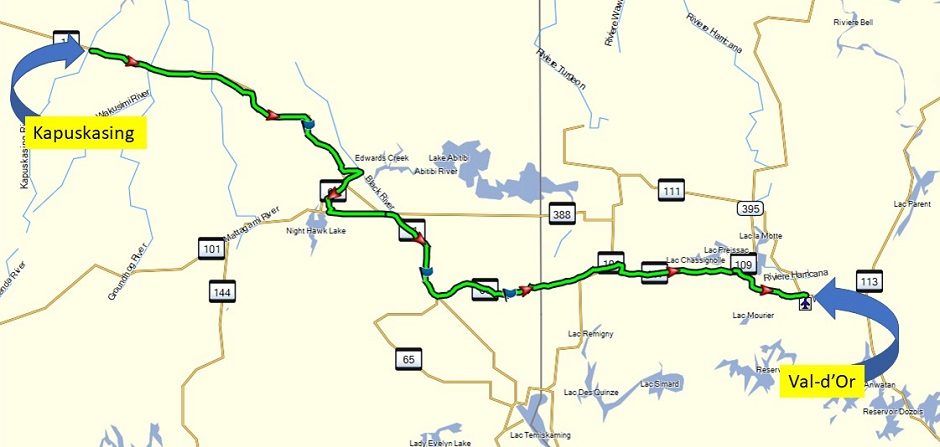
|
|||||||||||||||||||||||||||||||||||||||||||||||||||||||||||||||
| A lot of driving again today - three days in a row we have done 500k or so, but there were some fun stops today as well. We left Kapuskasing earlyish and drove to Iroquois Falls where we had seen a report of a Pioneer Museum - which turned out to be a small building with a note to be careful of the birds nesting over the door. I tell you, these birds were not messing about. We took some quick snapshots of the murals and artifacts and ran in through the front door. | |||||||||||||||||||||||||||||||||||||||||||||||||||||||||||||||

|
|||||||||||||||||||||||||||||||||||||||||||||||||||||||||||||||
|
Perhaps not an auspicious start, but we went in anyway and found a
very full set of rooms with all kinds of fun things. The main theme
was the Abitibi paper mill - which was the reason for the town being
here at all so this makes sense. We got a personal tour from one of
the (three!) people who run the museum. The gentleman had worked at the mill
for more than 30 years - so we felt like we really got the low-down
on things. The mill was started by an investor who was looking for
mining opportunities, but the students sent up here to north-eastern
Ontario did not find gold and reported that there were lots of rivers
and trees so the investor - Frank Anson - decided to build a paper
mill instead and created a modern township around the falls along the
lines of the Garden Cities in the UK (Kapuskasing was another another
example of this). It made for a well-planned community and the as
the mill grew to be one of the biggest newsprint producers in the
world, everything wsa looking good - until demand for newsprint
plummeted and the mill was finally closed in 2014.
What was fascinating for us was how the mill covered everything - from logging crews, moving the logs down the river (at first, then later by train and road), generating the electricity (from 3 hydro dams along the river) and then making the paper (with all that that entailed). We asked about the smell (remembering Moss and Hunsfoss/Vennesla in Norway) and they said that there wasn't much smell as the way they made the paper here was different (grinding process rather than rotten-egg-smelling chemicals) - and they built the town site upwind from the Mill! |
|||||||||||||||||||||||||||||||||||||||||||||||||||||||||||||||

|
|||||||||||||||||||||||||||||||||||||||||||||||||||||||||||||||
| As the demand for newsprint paper more or less disappeared, they kept one of the old machines to run special paper production if it could be run profitable. The managed to land several contracts to keep the plant going for a few more years. This included supplying the global market for Tampax paper applicators particularly because they were so cheap to make without any perfume, dyes, and chlorine bleaching. Who would have thought? | |||||||||||||||||||||||||||||||||||||||||||||||||||||||||||||||

|
|||||||||||||||||||||||||||||||||||||||||||||||||||||||||||||||
|
There were a lot of other fun exhibits in the museum - information on
how much food was needed to provide lumberjacks with 6,200 calories per day, and what they were
paid in 1936 (4.5 - 10 cents per 16-foot log). Their basic instruments
were on display as well as photos of their camps and the boats they travelled
and sometimes lived on.
He told us about students and other young persons being hired during the summer to push logs away from shorelines to make sure they float down the Abitibi river. Before we had heard stories of them also being hired to re-plant trees. One such example is told humorously by our favourite storyteller, Stuart McLean: Vinyl Cafe link on YouTube |
|||||||||||||||||||||||||||||||||||||||||||||||||||||||||||||||
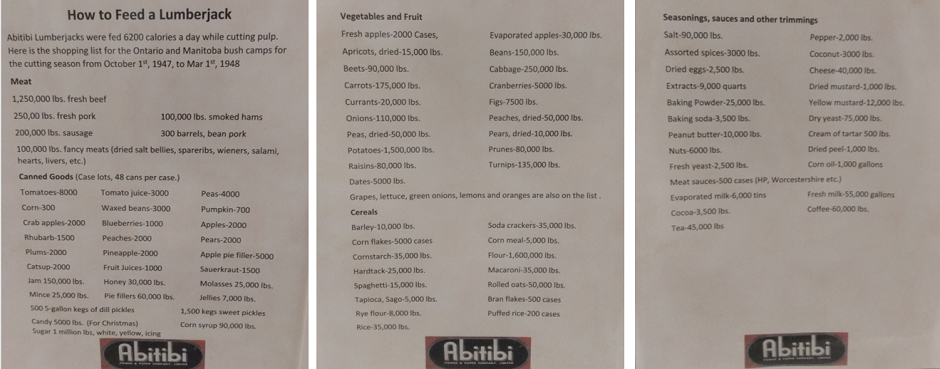

|
|||||||||||||||||||||||||||||||||||||||||||||||||||||||||||||||
| A photo of the old newsprint making machines showed how the wet felts were periodically replaced as they were too worn and then converted into blankets for local people in need. Apparently the burlap-type felts were better as blankets than in the machines. Technological advancement meant wet felts were later made of nylon. | |||||||||||||||||||||||||||||||||||||||||||||||||||||||||||||||
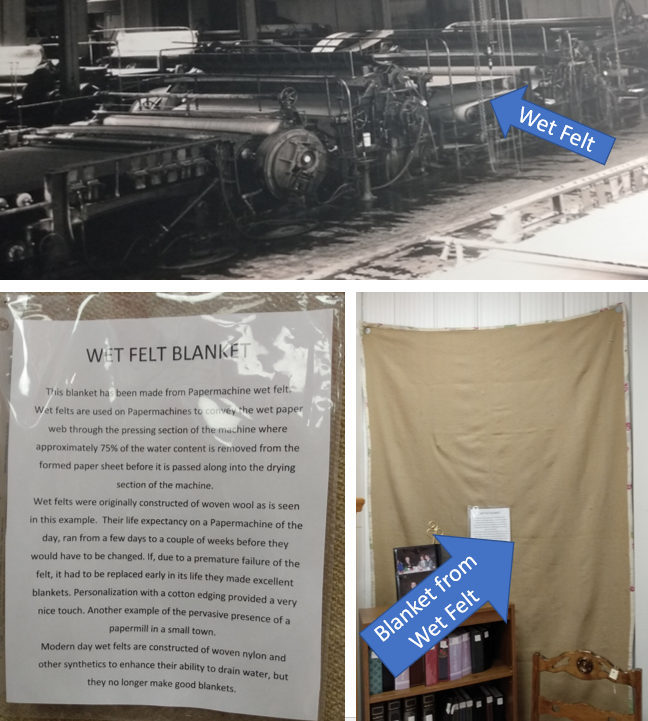
|
|||||||||||||||||||||||||||||||||||||||||||||||||||||||||||||||
| Visiting children would particularly love the collection of stuffed animals and skeletons. The museum has special permits to hold some of these because they are rare species. While the kids (and us?) thought we could spot a dinosaur skeleton, it was in fact just a rabbit... doh! | |||||||||||||||||||||||||||||||||||||||||||||||||||||||||||||||
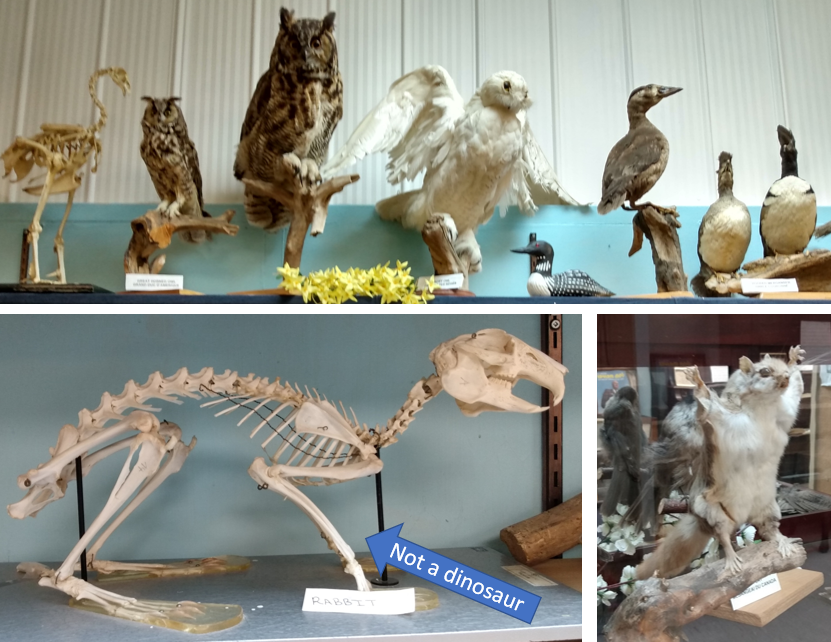
|
|||||||||||||||||||||||||||||||||||||||||||||||||||||||||||||||
| Some of the old artefacts were very familiar such as wooden buckets, washboard, and spinning wheel. Other town history photos included music such as an ode to famous Al Perini, who used to visit here from Chicago. The piano which had entertained many locals at their regular dances in the town hall. And an old movie projector used during the time when silent movies where all the rage. | |||||||||||||||||||||||||||||||||||||||||||||||||||||||||||||||


|
|||||||||||||||||||||||||||||||||||||||||||||||||||||||||||||||
| There was another town history in the form of school photos and local sports memorabilia. We could have spent quite a bit longer, but we had to go for lunch and then drive a way further so we said our thank-yous and left. | |||||||||||||||||||||||||||||||||||||||||||||||||||||||||||||||
|
Lunch was our usual - but in a provincial park outside Timmins. It
was called Kettle Lakes Park and there were a whole lot of glacial
lakes there - in the middle of forest. These lakes were made when large blocks of
glacier was left behind 10,000 years ago when the rest melted. These blocks were covered in
sand and gravel. When they finally melted, they left behind depressions that
then filled with water.
The Provincial Park now has facilities here for us and others to enjoy, including kayak, canoe, paddle board, paddle boat, and a wheeled contraption which we guess is used to help people in wheelchairs enjoy the lake. |
|||||||||||||||||||||||||||||||||||||||||||||||||||||||||||||||

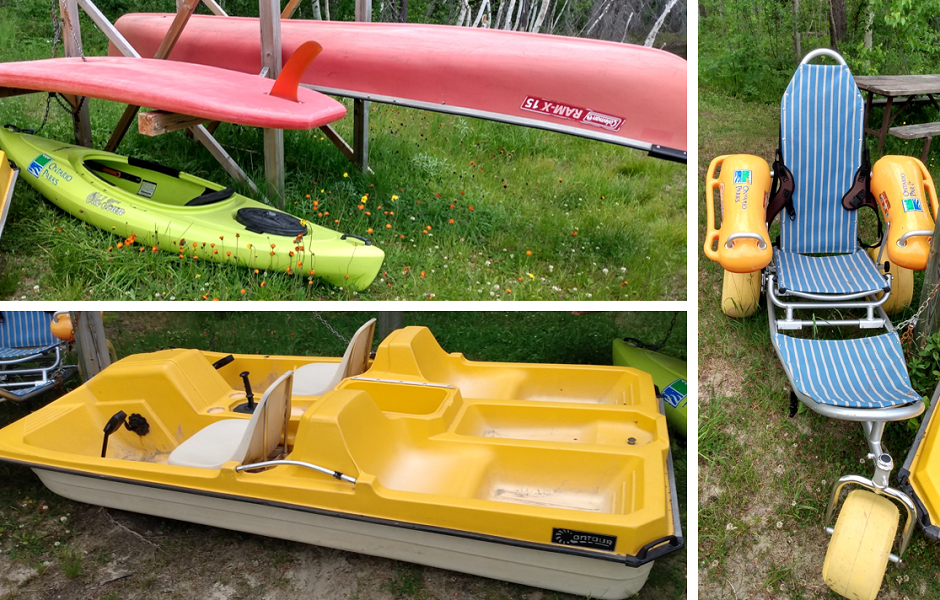
|
|||||||||||||||||||||||||||||||||||||||||||||||||||||||||||||||
| Actually, lunch wasn't the "usual" as we had a couple of eggs left over and we decided we needed to eat them (before they went off) so we fried them to have on our roll instead of just ham and cheese (and pickle). We had tomato ketchup and salt and the little pancake pan is a perfect size for one egg. We still had a cup of tea as well(of course) and then we went off into Quebec. Fried egg butties and tea - I think Hild has been converted into real Northerner! | |||||||||||||||||||||||||||||||||||||||||||||||||||||||||||||||
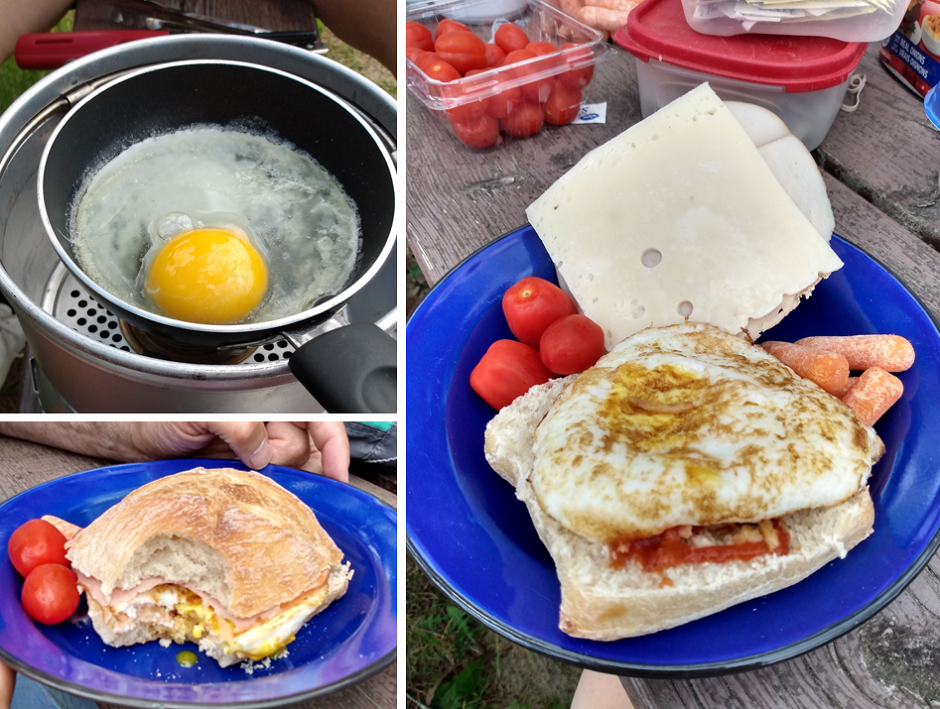
|
|||||||||||||||||||||||||||||||||||||||||||||||||||||||||||||||
|
It was a nice place to enjoy a picnic, but when
we went for a walk we had a lot of bugs around us - flies and mozzies
for most part - so we had to get the DEET spray out for almost the
first time this trip. This has actually been one of the happier
accidents of the trip - we travelled too early in the season to be
troubled by the bugs! Maybe it was just that it was a cold spring,
but the upside of slogging through the snow is no mozzies!
The trail around Tamarack Lake and over to Pine Lake gave nice views of the lakes, and also many beautiful spring flowers: Canadian Bunchberry, Pink Lady’s Slipper, Bluebead Lily, and Canada Mayflower. |
|||||||||||||||||||||||||||||||||||||||||||||||||||||||||||||||

|
|||||||||||||||||||||||||||||||||||||||||||||||||||||||||||||||
| As is our quirky selves, we skipped more famous Timmins and took the route through Kirkland Lake - just in case it had anything to do with our favourite Costco. Some research taught us that the Costco Kirkland brand dates back only to the 1995 and refers to the original Costco town in Washington State. Ah well - we can still visit this town. | |||||||||||||||||||||||||||||||||||||||||||||||||||||||||||||||
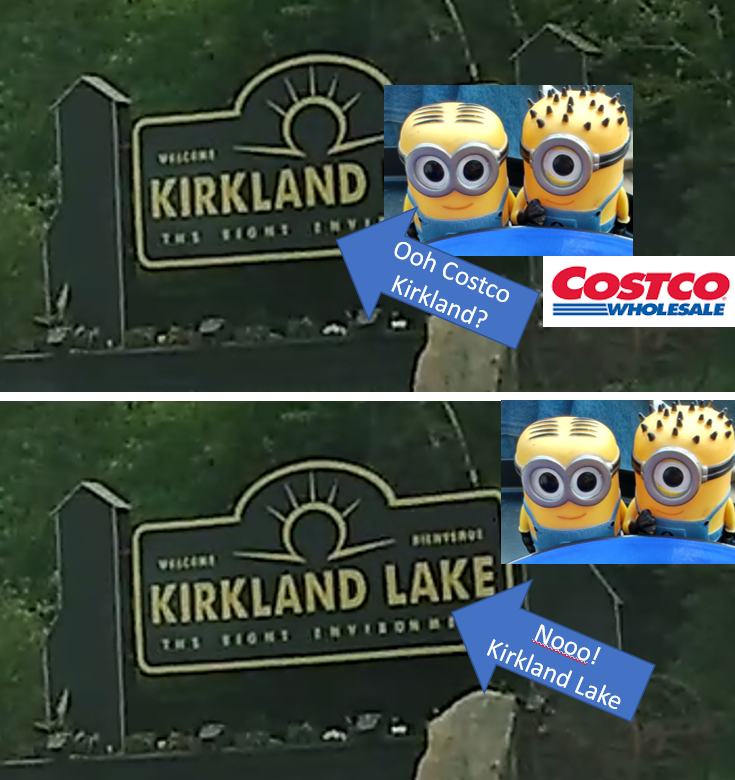
|
|||||||||||||||||||||||||||||||||||||||||||||||||||||||||||||||
| We started seeing many mine shafts as we were leaving Ontario: Kirkland Lake Gold, Toburn, Larder Gold Project. And suddenly we were welcomed into Quebec - our sixth province of the trip. We have found out that this part of Quebec was originally developed by Ontarians moving eastwards after veins of gold and other precious metals after the Ontario "Gold Rush" of the early 20th century. | |||||||||||||||||||||||||||||||||||||||||||||||||||||||||||||||
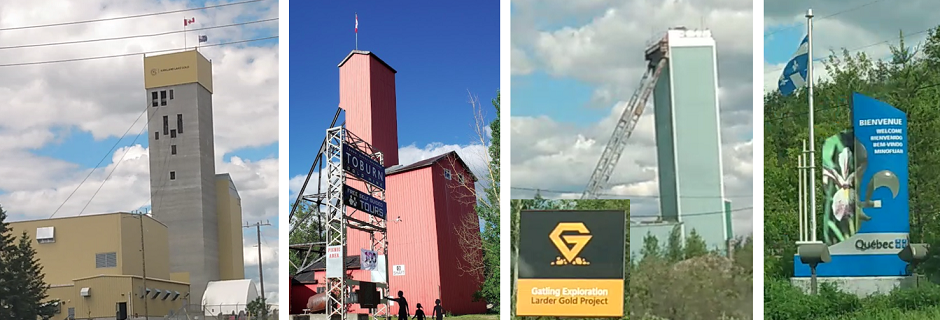
|
|||||||||||||||||||||||||||||||||||||||||||||||||||||||||||||||
Of peculiar items today we had:
|
|||||||||||||||||||||||||||||||||||||||||||||||||||||||||||||||

|
|||||||||||||||||||||||||||||||||||||||||||||||||||||||||||||||
| It is quite hilly country with plenty of ups and downs so even with straight roads you cannot overtake too easily - which didn't stop some of the Quebec drivers! But we made it to Val-d'Or (Golden Valley) and we have a gold mine tour booked for tomorrow - so it needs an early night! | |||||||||||||||||||||||||||||||||||||||||||||||||||||||||||||||
|
Coming up: Exploring Val-d'Or. | Start | Nerdy | The Largest... | Ornaments | Go To Previous Day | Go To Next Day |
|||||||||||||||||||||||||||||||||||||||||||||||||||||||||||||||
May/June 2022

